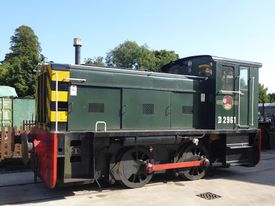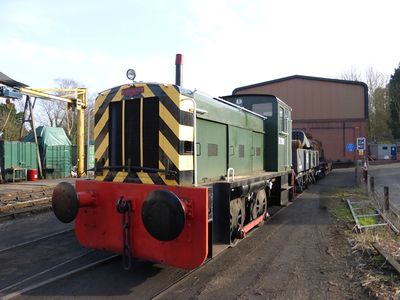Ruston and Hornsby 165hp Diesel Electric Shunter D2961
| Ruston and Hornsby 165hp Diesel Electric Shunter D2961 | |
|---|---|
 D2961 at Bridgnorth in September 2020 | |
| Built By | Ruston & Hornsby |
| Configuration | 0-4-0 |
| Power type | Diesel Electrical |
| Status | Operational |
| Loco Number | D2961 (fictitious) |
| Other Numbers | Works no 418596 |
| History | |
| Built | 1957 |
| Designed By | Ruston & Hornsby |
| Type | 165 h.p. |
| 1983 | Arrived on SVR |
| Technical | |
| Length | 22ft 1in |
| Weight | 28t |
Ruston and Hornsby 165hp Diesel Electric Shunter D2961 is one of a number of 165 h.p. 0-4-0 diesel shunters at the SVR, but is the only one with Diesel Electric transmission, producing a sound reminiscent of a tram in operation[1].
Contents
Contents
Service
The locomotive was built by Ruston and Hornsby ("R&H") of Lincoln as works number 418596 of 1957, and was delivered new to ICI Limited at Winnington, Cheshire,[1] where it carried the name 'Stephenson'.[2]
In early 1965 418596 moved to T.H. Ward of Sheffield, and late in the same year moved on to Higgs and Hill, Contractors for Fiddlers Ferry Power Station. After returning to Wards, it moved to Tunnel Cement at Birsley, Flint in 1969.[1]
In 1972 the locomotive was sold to Tinsley and Lovatt of Trentham, Staffs for overhaul, after which it was sold to its final owners, Patent Shaft Steelworks of Wednesbury[1].
Preservation
In the first years of SVR preservation, shunting duties and engineering trains used steam locomotives, in particular the ex-industrials 2047 Warwickshire and 686 The Lady Armaghdale. However the ease of use of diesel shunters led to their early adoption, with Highflier the first to arrive in 1971. The Red Ruston, the first of the 165 h.p. R&H shunters was next to arrive in 1972, followed by Mary also in 1972 and Yellow Peril in 1975. All saw regular service at a time when the railway was developing and expanding to Bewdley, but with the exception of the Red Ruston they proved underpowered for the job.[3]
The closure of Patent Shaft in 1980 gave the SVR the opportunity to acquire a further four 165 h.p. R&H shunters at 'bargain rates'. They were painted in a 'bilious yellow' and were rather battered in places, having apparently been in the habit of pushing their way through piles of steel plate. Diesel Electric 418596 (unnamed) was in better condition than the rest and was initially intended for P-Way use, while the plan for the three Diesel Mechanical shunters Alan, William and Archibald was that two would be allocated to the terminal stations allowing the third to be under repair at any given time. Two spare engines were also obtained.[4]
When 418596 arrived on the SVR on 1 November 1980, it was owned by SVR(H) having been acquired at a cost of £1000. It was repainted in BR green livery with the later BR 'ferret and dartboard' emblem, and given the fictitious number D2961 in keeping with former BR fleet numbers.[1] After receiving mechanical attention it was allocated to the P-Way department as intended. However by summer 1981 experience proved that it was better suited to yard work and it had become resident in Bridgnorth yard.[5] It quickly transpired that William and Archibald, the latter owned by Pete Cherry, were not going to be kept long-term so ownership of Archibald and D2961 was simply swapped, with Pete Cherry becoming owner of D2961.[6] Both William and Archibald were subsequently cannibalised for spare parts.
D2961 was used as the principal Bridgnorth yard shunter until the arrival of the more powerful BR Class 08 D3586 in 1986,[1] after which it continued in service at Bridgnorth performing movements in and out of the boiler shop and light yard shunts. However by spring 1997 D2961 was out of traffic due to a blown engine. A Gardner bus engine had been acquired to see if it was possible to achieve an easy engine swap[7] although with no success.
In spring 2003 a report from Trevor Davies in SVR News noted that the Class 08 Society were assisting with returning "the Bridgnorth boiler shop Ruston" to service by repairing and restoring parts, in addition to their main activity of restoring 08133.[8] By winter of that year D2961 was at Kidderminster with repairs still incomplete.[9]
After that time progress was slow for some years. By summer 2010 renovation work was still in progress at Kidderminster, although the diesel set had been started for the first time in several years during the preceding winter. This had required D2961's engine to be rebuilt from its crankshaft and also provided with a reconditioned fuel pump and injectors. At that stage it still required work on the brake and suspension systems together with a full electrical overhaul before being available for service.[10]
By summer 2012 the overhaul of the fuel and brake systems had been completed after considerable effort by a small team of our volunteers, with a reconditioned brake valve being fitted along with a new safety valve. This had enabled the locomotive to move under its own power for the first time in many years. The next six months saw the wiring completed, new spotlights fitted, and generator traction motor guards made and fitted, although the locomotive suffered a setback in November when it was hit by an attempted theft whilst in Kidderminster yard.[10]
Considerable work was also carried out on the bodywork during the renovation. The cab and its roof were almost completely replaced, as the original platework was well past its prime. The cab received all-new woodwork including the floor, and tool and battery lockers. New cab doors were fitted with '08' style door locks and handles, allowing all qualified shunt locomotive drivers to gain access.[10]
D2961 eventually returned to service at Bridgnorth in 2013. Trevor Davies summed up the renovation in SVR News by noting "There is a lesson to be learned here, that is if you are not going to see a big repair project through, then please leave it in one piece, as it makes it easier for those who may wish to take up the baton at a later stage. Preservation is full of projects that started with good intentions, met with a dose of reality and as a consequence foundered."[10]
It is owned by Pete Cherry.[11]. As of 2024[update] D2961 is still based at Bridgnorth and is serviceable.
See also
References
- ↑ 1.0 1.1 1.2 1.3 1.4 1.5 SVR Stock Book Ninth Edition
- ↑ SVR News 59
- ↑ SVR News 133, "The Early Shunters", Chris Magner
- ↑ SVR News 58
- ↑ SVR News 60
- ↑ Pete Cherry
- ↑ SVR News 122
- ↑ SVR News 143
- ↑ SVR News 146
- ↑ 10.0 10.1 10.2 10.3 SVR News 170, 178, 181
- ↑ SVR Diesel fleet
| ||||||||||||||||||||||||||||||||||||||||||||||||||||||||||||||||||||||||
